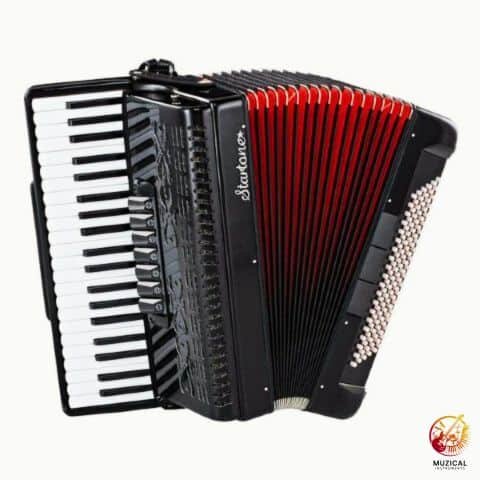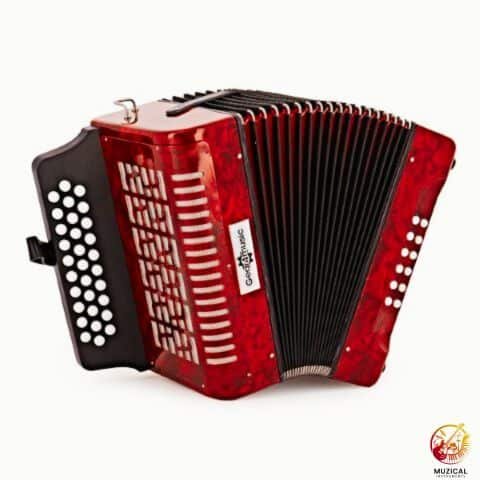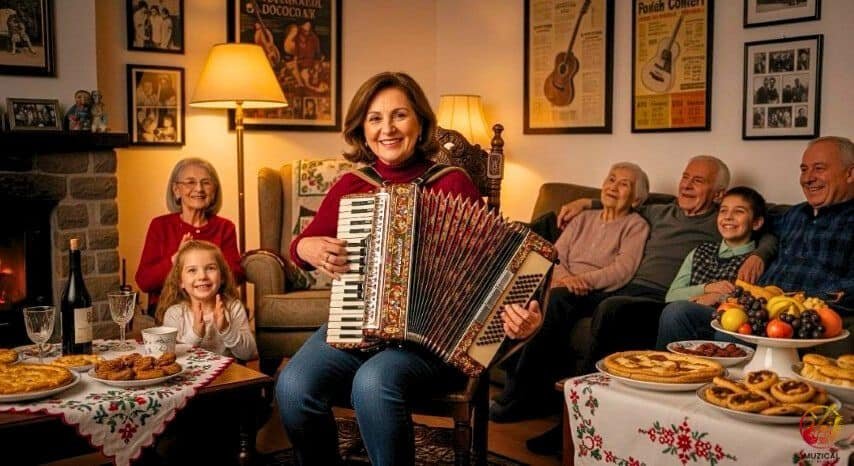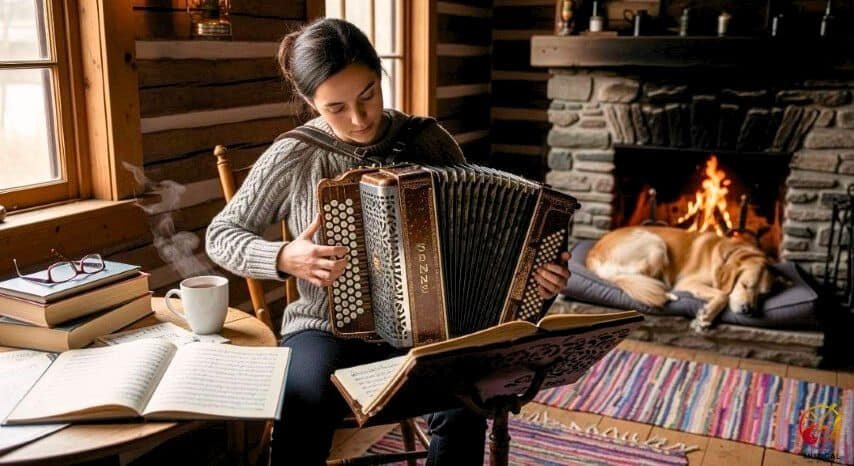Unpacking the Difference Between Piano and Button Accordion
The biggest difference between piano and button accordion is the keyboard on the right-hand side. But that one change leads to big differences in how you play, what music sounds best, and how easy each one is to learn.
If you feel drawn to the powerful, room filling sound of the accordion, figuring out which type is right for you is your most important first step. Picking the wrong one for your goals can be frustrating, but finding the right fit can be the start of a fun musical journey.
This isn’t just about looks; it’s about what feels comfortable to play and what works for the music you love.
In this guide, we’ll go beyond just “keys vs buttons.” We’ll break down how each type works, look at the important left hand buttons that create the accordion’s rhythm, and give you an honest look at what it’s like to learn each one.
By the end, you’ll know exactly how to choose the accordion that will help you play the music you’ve always wanted to play.
What Is the Most Obvious Difference in How They Look and Feel?
When you put them side-by-side, the comparison seems pretty simple. The piano accordion has a keyboard that looks just like a small piano. For most people, this feels familiar and friendly.


The button accordion, on the other hand, can look a little confusing with its grid of round buttons. This is a big reason why many beginners lean toward the piano accordion first.
The piano accordion‘s right-hand keyboard is laid out just like a piano. It has all the white and black keys you need to play in any key. If you’ve ever messed around with a piano, your brain already knows the layout. You can find the notes and see how the scales work. This makes it feel much less scary when you’re just starting.
Button accordions trade that familiar layout for a design that is smaller and often more efficient to play. There are two main types here: Chromatic Button Accordions (CBA) and Diatonic Button Accordions (DBA). The chromatic kind has all the notes, just like a piano accordion, but they are packed into three to five compact rows of buttons. This design is actually easier on your hands. You don’t have to stretch and jump around as much to play notes that are far apart. Think of it this way: a piano keyboard is like a long ruler. A button keyboard is like a compact calculator. All the functions are packed tightly together, so your fingers don’t have to travel as far. This clever design means a button accordion can have more notes than a piano accordion of the same size and weight.
How the Layout Changes the Music: A Key Difference Between Piano and Button Accordion
This is where the real difference between piano and button accordion starts to matter. The layout of the right hand completely changes what’s easy or hard to play, especially when it comes to playing fast or in different keys.
For the piano accordion player, the big plus is that if you know any piano, you already have a head start. The challenge comes with faster, more complicated music. To play a fast scale, your whole hand has to move up and down the keyboard. A big jump between notes can be tricky to play smoothly. Great players can make it look easy, but the layout itself can be a hurdle.


The Chromatic Button Accordion (CBA) was invented to solve this exact problem. The buttons are placed in a way that lets scales and tunes fall right under your fingers with very little movement.
But here’s the secret weapon: the fingering pattern for a scale is the exact same no matter what key you’re in. You learn one pattern for a major scale, and you can use that same pattern to play in all 12 keys just by starting on a different button. This is a huge advantage for playing complex songs or making up music on the spot.
Then there is the Diatonic Button Accordion (DBA). This instrument is a whole different animal. It’s bisonoric, which is a fancy way of saying each button plays two different notes, one when you push the bellows in, and another when you pull them out.
It’s also built to play in only one or two keys, like C and G. This sounds limited, but for folk music, it’s perfect. This push pull action forces a sort of “breathing” rhythm into the music, which is the soul of styles like Irish jigs, Cajun music, and Tex Mex polka. The instrument itself helps you find the right groove.
| Feature | Piano Accordion (PA) | Chromatic Button Accordion (CBA) | Diatonic Button Accordion (DBA) |
|---|---|---|---|
| Right-Hand Side | Looks like a piano. | A grid of 3-5 rows of buttons. | A grid of 1-3 rows of buttons. |
| For Piano Players | Easy to understand; skills carry over. | Hard at first; it’s a new system to learn. | Not easy; have to learn the push-pull system. |
| Changing Keys | You have to learn a new fingering for each key. | One fingering pattern works for every key. | Hard to play in keys it wasn’t built for. |
| Feel and Size | Can be bulky; requires more hand movement. | Very efficient; lots of notes in a small space. | Usually very small and light. |
| Best For These Genres | Polka, Tango, Jazz, Pop music. | Classical, European Folk, Jazz. | Irish, Cajun, Tex-Mex (Norteño) Folk. |
Are the Left-Hand Buttons the Same on Both?
While the right hand plays the melody, the left hand is the accordion’s rhythm section. It plays the bass notes and chords that back you up. Luckily, the left-hand system is often the same on both piano and button accordions, but there are important types to know about.


Most accordions today use the Stradella bass system. That big grid of up to 120 buttons on the left side looks complicated, but it’s actually very clever. The two rows of buttons closest to the bellows are single bass notes.
The other four rows are chord buttons. When you press one of these, you get a full major, minor, 7th, or diminished chord with a single finger. This makes it incredibly easy to play a bass note and then a chord, creating that classic “oom-pah” rhythm. It’s like having a backup band built right in.
However, for very complex music like classical pieces, those pre-set chords don’t work. Composers like Bach wrote moving bass lines, not simple chords. For that, players need a Free Bass system.
On a free bass accordion, those chord buttons are turned into single notes, just like the right-hand side. This lets the player use their left hand to play melodies or complicated bass parts.
Many high-end accordions, both piano and button, are “converter” models with a switch that lets you go back and forth between Stradella and Free Bass. A key difference between piano and button accordion isn’t usually the bass system, as both can have either, but it’s a feature serious players look for.
Diatonic button accordions usually have a much simpler left hand, with just enough buttons to play the basic chords for their specific keys.
Which Accordion Is Easier for a Beginner?
This is the big question everyone asks. The truth is, it depends on you and what you want to play. There isn’t one “easier” accordion, just different challenges at the beginning.
The Piano Accordion is often the easiest to start with. The keyboard is familiar, and you can pick out a simple tune pretty quickly. This makes it really encouraging when you’re brand new. You can find teachers for piano accordion more easily, and the road to playing simple songs is very clear. Understanding this initial ease of use is part of understanding the practical difference between piano and button accordion.
The Diatonic Button Accordion can be the fastest way to sound “real” if you want to play a certain kind of folk music. You can learn a simple jig pretty fast because the instrument is designed for it. The hard part is getting used to the push-pull nature of the notes. This can be confusing at first. Your brain has to learn that one button does two things.
The Chromatic Button Accordion is probably the hardest to learn right at the start. The grid of buttons doesn’t make sense visually at first. You have to put in the time to memorize the layout. But, after that initial work, things get easier. Because the fingering is the same for every key, many feel it’s more efficient in the long run for becoming a highly skilled player.
Expert Insight: My Advice for New Players Here’s my honest advice. Let the music you love decide for you.
- If you dream of playing Irish reels or Cajun music, you should get a Diatonic Button Accordion. It’s the right tool for the job.
- If you have a piano background or want to play different styles like pop, jazz, or tango, the Piano Accordion is your best bet.
- If you want to be a classical master or play really fast European folk music, the Chromatic Button Accordion is the most powerful choice, but be ready for a challenge at the start.
What Music Fits Each Accordion Best? Exploring a Core Difference Between Piano and Button Accordion

Different accordions are popular in different kinds of music for a good reason. The design of each one makes it perfect for certain sounds. This preference is another major difference between piano and button accordion.
The Piano Accordion is the great all-around player. You’ll hear it in all kinds of music all over the world. It’s the sound behind lively American Polka, the passionate heart of Argentinian Tango, and a common instrument in pop and rock music. When a band wants that classic accordion sound, the piano accordion is usually what they grab.
The Chromatic Button Accordion is the choice for players who want to be masters of their instrument. In classical music, the CBA is king. Its speed and efficient layout are needed to play difficult pieces. It’s also the main accordion in the super-fast and complex folk music of Eastern Europe and the Balkans.
The Diatonic Button Accordion is a true specialist. It’s tied directly to specific folk traditions. You can’t get the real sound of Irish music without the bouncy rhythm of a diatonic box. The exciting sound of Cajun and Zydeco music from Louisiana comes from a simple, one-row diatonic accordion. And the beloved Norteño and Conjunto music from the Texas Mexico border is powered by the two-row diatonic accordion.
| Music Genre | Best Accordion Type | Why It Works So Well |
|---|---|---|
| Polka (American Style) | Piano Accordion | Has a strong “oom-pah” rhythm section and a familiar keyboard for melodies. |
| Classical Music | Chromatic Button Accordion | Needed to play fast, complex parts and independent bass lines. |
| Irish Folk Music | Diatonic Button Accordion | The push-pull action creates the unique, bouncy rhythm of the music. |
| Cajun & Zydeco | Diatonic Button Accordion | Gives the punchy, rhythmic sound that defines this style of music. |
| Tango | Piano Accordion or Bandoneon | The PA can handle the dramatic melodies and complex chords of tango. |
| Modern Jazz | Piano or Chromatic Button | Both can play in any key, which is necessary for jazz improvisation. |
Final Thoughts
In the end, the difference between piano and button accordion comes down to a simple choice: a familiar layout versus a more efficient one. The piano accordion gives you a friendly and versatile path into many kinds of music. The button accordion is a more specialized tool, either for mastering very difficult music or for getting the perfect, authentic sound of certain folk styles.
The difference between piano and button accordion isn’t about which is better, but which is better for you.
The best thing you can do now is listen. Go online and watch videos of professionals playing each type. Close your eyes and just listen to the sound. Which one pulls you in? Pay attention to the music you already love and see which accordion is being played. You’re not just choosing an instrument; you’re choosing a voice. So, which one do you want to speak with?
FAQ: Difference Between Piano and Button Accordion
Here are answers to some of the most common questions people have when trying to understand the difference between piano and button accordions.
1. So, which accordion is really easier for a total beginner?
Honestly, the piano accordion is usually easier to start with. Because the keyboard looks just like a piano, it feels familiar, and you can probably pick out a simple tune on your first day. That’s really encouraging!
But “easy” really depends on your goals. If your dream is to play Irish jigs, a diatonic button accordion will get you that “authentic” sound much faster, even though learning the push-pull action of the bellows is a bit tricky at first.
2. Can I play songs written for piano on a button accordion?
Yes, you definitely can! This is especially true for a Chromatic Button Accordion (CBA). A CBA has all the same notes as a piano, so you can play any melody you want. The only thing that changes is how your fingers play the notes. Think of it like reading a book in another language, the story (the song) is the same, but the words (your finger movements) are different.
3. I’ve heard of a bandoneon. Is that the same as a button accordion?
That’s a great question, as they look very similar! A bandoneon is actually a different instrument, though it’s part of the same family. It’s famous for creating the sound of Tango music. The main differences are that bandoneons typically don’t have the pre-set chord buttons that accordions do on the left side, and their button layout is unique. It’s best to think of them as cousins to the accordion, not twins.
4. How much does a decent beginner accordion cost?
You don’t need to spend a fortune to get started. A good new student-model piano accordion can run anywhere from $400 to $800. You can often find great deals on used accordions, but it’s a good idea to have an experienced player or a repair shop check it for any issues like air leaks or sticky keys. Just be cautious of the super-cheap accordions under $200 you might see online, as they are often more like toys and can be very frustrating to learn on.
5. Why are there different button systems, like B-System and C-System?
This question is for Chromatic Button Accordions (CBAs). B-System and C-System are simply two different ways of arranging the notes on the button grid—they are basically mirror images of each other. One isn’t better than the other; it’s just a matter of what’s more popular in different parts of the world. For example, C-System is very common in France, while B-System is the standard in Russia. As a beginner, you don’t need to worry too much about this. Your teacher will simply tell you which system they teach.
6. Accordions look pretty heavy. How do I pick the right size for me?
You’re right, they can be! Comfort is key, so size is very important. Accordion size is often described by the number of buttons on the left hand (the bass side), like a “48-bass,” “72-bass,” or a full-size “120-bass.” For most adults starting out, a 48-bass or 72-bass model is perfect. They are much lighter than a full-size professional accordion but still have more than enough notes and chords to play thousands of songs. For kids, there are even smaller and lighter 12-bass models. If you ever get the chance, try holding one in a music store to see what feels right for your body.
